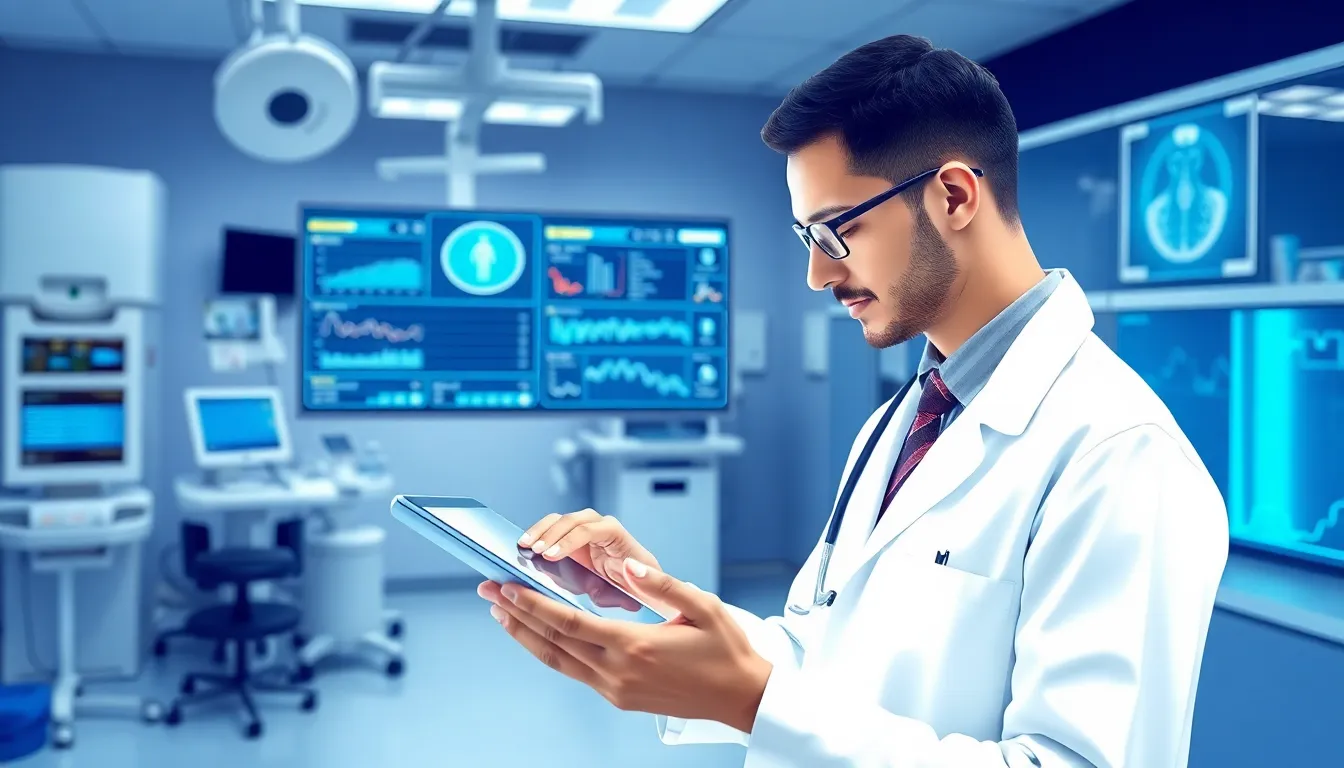Table of Contents
ToggleImagine a world where your doctor knows your health status before you even step into the office. Welcome to the Healthcare Internet of Things (IoT), where smart devices are revolutionizing patient care faster than you can say “check-up.” With a network of connected gadgets—from wearable fitness trackers to smart pill dispensers—healthcare is no longer just about stethoscopes and waiting rooms.
This tech-savvy approach not only keeps tabs on your health but also makes it easier for medical professionals to provide personalized care. Picture your smartwatch sending your heart rate to your doctor while you binge-watch your favorite series. It’s like having a health assistant that never sleeps. Dive into the fascinating world of Healthcare IoT and discover how it’s changing the game for patients and providers alike.
Overview of Healthcare Internet of Things
Healthcare Internet of Things (IoT) describes a network of connected devices transforming patient care. Connected devices collect and transmit health data, increasing the efficiency of healthcare delivery. Examples include wearable devices, smart thermometers, and remote monitoring systems. These innovations allow healthcare providers to access real-time data, enhancing their ability to diagnose and treat patients effectively.
Wearable devices, like fitness trackers, monitor various health metrics such as heart rate and activity levels. This continuous monitoring supports proactive healthcare interventions. Smart pill dispensers ensure patients adhere to medication schedules, minimizing the risk of complications. Remote monitoring systems facilitate communication between patients and providers, improving patient outcomes.
Integrating IoT in healthcare also streamlines administrative tasks. Data collected from connected devices assists in organizing patient records, reducing time spent on documentation. Enhanced data analytics provide insights into patient conditions, allowing for tailored treatment plans. Improved data access promotes collaboration among healthcare teams.
Healthcare IoT addresses challenges in chronic disease management. Chronic patients benefit from constant monitoring, resulting in timely interventions and increased quality of life. For instance, diabetes management can improve through continuous glucose monitoring systems.
Security remains a primary concern in implementing healthcare IoT. Protecting patient data from breaches is crucial, as connected devices can be vulnerable to hacking. Organizations must adopt robust cybersecurity measures to safeguard sensitive information and maintain patient trust.
Healthcare IoT shapes a future where patient-centered care becomes the norm. As technology advances, the integration of IoT will continue to evolve, emphasizing efficiency and improving overall healthcare delivery.
Benefits of Healthcare Internet of Things

The Healthcare Internet of Things (IoT) delivers numerous advantages that enhance overall care delivery and efficiency. Connected devices play a crucial role in elevating patient experiences.
Improved Patient Care
Remote monitoring fosters timely interventions. Continuous tracking of vital signs enables healthcare providers to respond quickly to changes in patients’ conditions. For instance, a wearable device can alert a doctor if a patient exhibits abnormal heart rates. Personalized treatment plans emerge from data-driven insights. Patients enjoy better engagement through real-time communication with their healthcare teams. Enhanced health outcomes stem from more proactive management of chronic conditions, leading to improved quality of life.
Enhanced Data Management
Data collection becomes streamlined through IoT-enabled devices. Real-time access to health information allows providers to make informed decisions efficiently. Automated systems manage patient records, minimizing clerical errors and enhancing data accuracy. Analytics tools uncover trends within patient populations, driving more effective treatment strategies. Compliance with regulations improves with organized data management systems. Effective data visualization aids in identifying critical health issues early. Clarity in data enhances collaboration among providers, leading to more cohesive patient care.
Challenges in Implementation
Implementing the Healthcare Internet of Things (IoT) presents various challenges that organizations must navigate to harness its full potential.
Security Concerns
Cybersecurity represents a significant challenge in the Healthcare IoT landscape. Protecting patient data from breaches ranks as a top priority for healthcare providers. Unauthorized access to sensitive information can lead to severe consequences, including identity theft and loss of patient trust. Organizations must prioritize robust cybersecurity measures. Regular software updates and vulnerability assessments support the prevention of data breaches. Compliance with regulations like the Health Insurance Portability and Accountability Act ensures that patient information remains secure. Collaboration with cybersecurity experts enhances the ability to safeguard systems effectively.
Interoperability Issues
Interoperability poses another challenge in the implementation of Healthcare IoT solutions. Different medical devices often use varying standards and protocols, complicating data sharing among them. Lack of compatibility can hinder seamless communication between devices, resulting in isolated data silos. Integrating various systems requires standardized protocols that facilitate data exchange. Organizations may need to invest in middleware solutions to bridge technological gaps. Additionally, fostering collaboration among manufacturers enhances the likelihood of creating interoperable devices. The advancement of universal health data exchange standards might simplify future integrations, promoting a more cohesive healthcare system.
Key Technologies in Healthcare Internet of Things
Healthcare IoT relies on various technologies that drive efficiency and improve patient care. Sensors play a crucial role, capturing vital health metrics such as heart rate, temperature, and activity levels. These devices gather real-time data, enabling healthcare providers to monitor patients remotely and intervene promptly when necessary.
Wearable devices, including fitness trackers and smartwatches, offer continuous health tracking. They enable patients to share data with their healthcare teams, fostering a collaborative approach to treatment. Through apps, users can access insights about their health, enhancing overall engagement with their wellness journey.
Telehealth technologies enhance virtual consultations, allowing for remote examinations and follow-ups. Video conferencing tools ensure that healthcare providers communicate effectively with patients from any location. This capability addresses accessibility issues, particularly for individuals in remote areas.
Cloud computing supports the storage and analysis of large volumes of health data. By centralizing information, it streamlines access for healthcare providers and enhances data management. Analytics tools leverage this data, helping identify trends and opportunities for tailored treatment strategies.
Artificial intelligence plays a significant role in analyzing patient data. It aids in predictive analytics, allowing for timely interventions in chronic disease management. Machine learning algorithms assist healthcare professionals in making informed decisions and improving diagnostic accuracy.
Cybersecurity measures protect patient data from breaches. Strong encryption protocols and regular software updates are critical for maintaining trust. Organizations prioritize compliance with regulations such as HIPAA to safeguard sensitive information.
Interoperability standards are essential for seamless communication between devices. Organizations invest in middleware solutions to facilitate the exchange of data across various systems. Collaborative efforts among manufacturers further promote the development of interoperable devices, enhancing the overall cohesion of the healthcare system.
Future Trends in Healthcare Internet of Things
Emerging trends in the Healthcare Internet of Things (IoT) indicate a significant shift toward integrating artificial intelligence with connected devices. AI enhances data analysis, allowing healthcare providers to predict patient outcomes and intervene earlier. Real-time analytics from wearable devices support data-driven decisions, fostering timely care.
Increasing adoption of telehealth technologies further transforms patient interactions. Virtual consultations streamline access to healthcare, especially for individuals in remote areas. Accessibility improves, enabling healthcare teams to monitor chronic conditions effectively.
Enhanced connectivity facilitates the rise of smart medical devices, such as intelligent blood glucose monitors and respiratory aids. These devices autonomously transmit health metrics to providers, minimizing the need for in-person visits. Wearable health trackers integrate seamlessly into daily life, promoting proactive health management.
Cybersecurity remains a priority as the number of connected devices rises. New standards and frameworks aim to protect patient data while ensuring compliance with regulations like HIPAA. Organizations are investing in robust security measures to safeguard sensitive information.
Interoperability challenges will spur innovation in data sharing protocols. Collaborations among device manufacturers are vital to creating a cohesive infrastructure. Standardized communication will enable seamless integration of various healthcare devices.
The future will also see a surge in patient engagement tools. Mobile health applications empower individuals to manage their health actively, leading to improved adherence to treatment plans. Patients are more involved in their care processes, promoting better health outcomes.
Telemedicine will continue to expand, offering greater convenience and broader access to healthcare services. Overall, these trends highlight a shift toward more connected, efficient, and patient-centered care in the ever-evolving Healthcare IoT landscape.
The Healthcare Internet of Things is reshaping the landscape of patient care. With the integration of connected devices, healthcare providers can offer more personalized and proactive treatment. This evolution not only enhances patient engagement but also streamlines administrative tasks, leading to improved healthcare delivery.
As technology continues to advance, the focus on cybersecurity and interoperability will be crucial. Organizations must prioritize these areas to ensure patient data remains secure while facilitating seamless communication between devices. The future of healthcare lies in the ongoing development of IoT, paving the way for a more efficient and patient-centered approach to health management.




